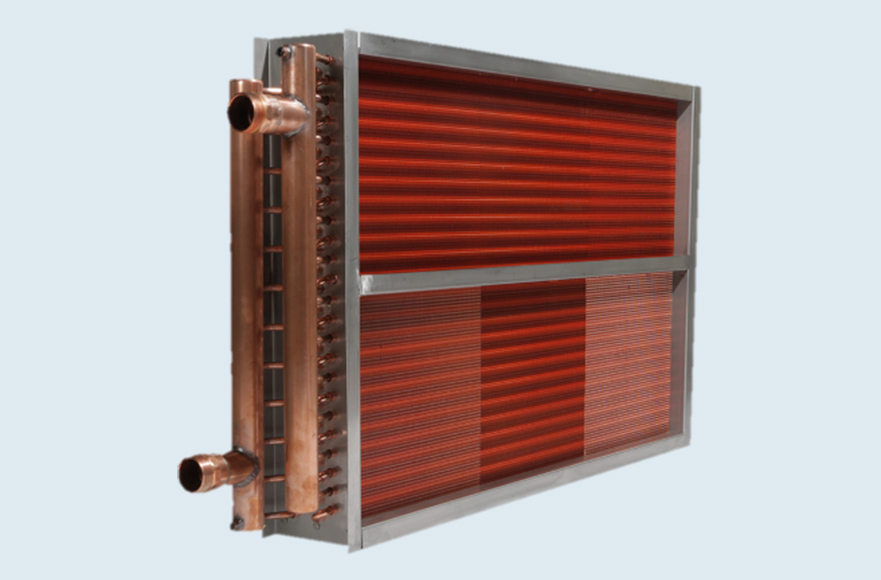Have Coil Questions? We Have Solutions!

We receive many verbal and written requests regarding fundamental coil problems with existing HVAC systems and industrial process systems. We also receive many requests on the specifying of coils for increased efficiency and longevity. The following are a few situations you may have experienced with some solutions that may save you future time and money.
Raul – Service Technician – Detroit, MI
“We have had terrible problems with leaks on steam heating coils, and they seem to multiply quickly. The coils are nine years old, and we are seeing leaks in the tube area two to three times per season. What’s causing these leaks?”
Problem: Over extended time, corrosive agents can create corrosion in the condensate of steam heating coils. The three main corrosive agents are: 1) oxygen, 2) ammonia, and 3) hydrogen dioxide. Coils can be leak free for years and suddenly have numerous leaks in a 2 to 3-year period. In older boiler systems with periodic treatment, the owner and service contractor may still have little to no knowledge that there is a problem occurring. Why? If you treat the steam heating system, you probably receive a report. That report shows the typical PH and other general information. It does not show the buildup of contaminants, because the test was not specifically looking for them.
Solution:The corrosive agents have been growing in parts per thousand for years and have finally reached a level where they are now attacking copper. In time, there are only two solutions. 1) Clean out the system and get rid of the corrosive agents, or 2) Replace the coils with a tube and header construction that is resistant to the corrosive agents that are presently destroying the copper tube coils. There are no other viable solutions.
Marty – Consulting Engineer – Sunnyvale, CA
“We often work with high tech companies and many of the process systems in manufacturing have two requirements. One is the type of metal allowed in the air or gas stream, and 2) higher temperatures. Many times, we must use expensive materials (stainless steel) due to these two factors. This significantly increases the price. Do you have any alternatives?”
Problem: The use of stainless steel in heat transfer finned- tube coils is a very expensive proposition. There is a double whammy when using stainless steel. One is the additional expense versus copper and aluminum, and 2) the amount of surface in the direction of flow to offset the lack of heat transfer efficiency. Not only do you initially pay more for the coils, but the air/gas flow resistance and fluid side resistance are all inflated as well.
Solution:A great alternative is today’s baked and dipped coatings. These coatings can easily withstand 250 degrees F of operation and only reduces heat transfer by a meager 1% to 1.5%. The addition of a coating on top of copper tube and aluminum fin may add 30% to 50% to the price, but this is minuscule compared to the addition of stainless steel. which may add three to four times the cost. If the system has temperatures above 250 degrees F, it may be wise to provide a pre-cooler (if cooling) or a final heater (if heating) in stainless steel due to the temperature. The other coils may be copper tube-aluminum fin coil with coating when temperatures go below 250 degrees F. This gives you protection and also provides much better efficiency.
Example: Cool nitrogen gas from 275 degrees F to 95 Degrees F. Use a stainless steel -aluminum fin coil to reduce temperature below 200 degrees F with a heat transfer fluid system and use a water cooling system on copper-aluminum coated coils to take it from there to 95 degrees F. The initial cost of the system is drastically reduced in number of rows in the direction of air flow and so is the systems gas and fluid side pressure resistance. The extra piping and system design is well worth it.
Sherman – Service Contractor – Orlando Fl
“When should I replace condenser coils in a system when they are known to be plugged?”
Solution: Most A/C systems are not designed with a service factor to overcome lack of air flow across condenser coils. Plugged coils have two problems – 1) reduced air flow and, 2) foreign material lodged in the fin surface acts as an insulator and reduces heat transfer even more. You will note that head pressures will be higher and each reading over an extended period will increase. When this starts to happen, the coils must be replaced because catastrophic compressor failures are on the horizon. Remember that condenser coils are the only HVAC coil installed in our industry that do not have a filter on its entering air side and are normally 16 to 22 fins per inch.
Tip of the Day
As often as possible, give your Coil Specialist the make and model number of the unit in which coils are to be replaced. Also, provide the coil model number if it can be found. Many times, we can cross reference these model numbers and save you a lot of time measuring and reviewing coils. It’s not always possible to cross reference the model number, but we can do it approximately 50% of the time, so it’s worth it to provide us with as much information as possible.
Historical Quote of the Day
“Success and achievement require 3 basics: Commitment, Determination and Consistency”!


